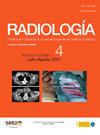Hallazgos de imagen en el traumatismo craneoencefálico grave
IF 1.1
Q3 RADIOLOGY, NUCLEAR MEDICINE & MEDICAL IMAGING
引用次数: 0
Abstract
Traumatic brain injury (TBI) is the leading cause of morbidity and mortality in young patients. The Marshall classification predicts six-month mortality and divides severe TBI patients into six groups based on CT findings in the acute phase of trauma. MRI also has prognostic value because it detects 30% more traumatic lesions, especially brainstem injury and diffuse axonal injury. Diffuse axonal injury occurs in three different anatomical areas, graded according to severity, and the greater the trauma, the deeper the brain involvement extends. Traumatic brainstem injuries with the worst prognosis are those of posterior location, with bilateral or haemorrhagic involvement. This article analyses the prognostic value of CT and MRI in the assessment of severe TBI and describes the main intracranial traumatic injuries.

严重颅脑损伤的影像学检查结果
创伤性脑损伤(TBI)是年轻患者发病和死亡的主要原因。马歇尔分类预测六个月的死亡率,并根据创伤急性期的CT表现将严重TBI患者分为六组。MRI还具有预后价值,因为它能检测到30%以上的创伤性病变,特别是脑干损伤和弥漫性轴索损伤。弥漫性轴索损伤发生在三个不同的解剖区域,根据严重程度分级,创伤越大,大脑受累越深。外伤性脑干损伤的预后最差的是后侧位置,双侧或出血累及。本文分析了CT和MRI在评估重型颅脑损伤中的预后价值,并介绍了主要的颅内伤。
本文章由计算机程序翻译,如有差异,请以英文原文为准。
求助全文
约1分钟内获得全文
求助全文
来源期刊

RADIOLOGIA
RADIOLOGY, NUCLEAR MEDICINE & MEDICAL IMAGING-
CiteScore
1.60
自引率
7.70%
发文量
105
审稿时长
52 days
期刊介绍:
La mejor revista para conocer de primera mano los originales más relevantes en la especialidad y las revisiones, casos y notas clínicas de mayor interés profesional. Además es la Publicación Oficial de la Sociedad Española de Radiología Médica.
 求助内容:
求助内容: 应助结果提醒方式:
应助结果提醒方式:


